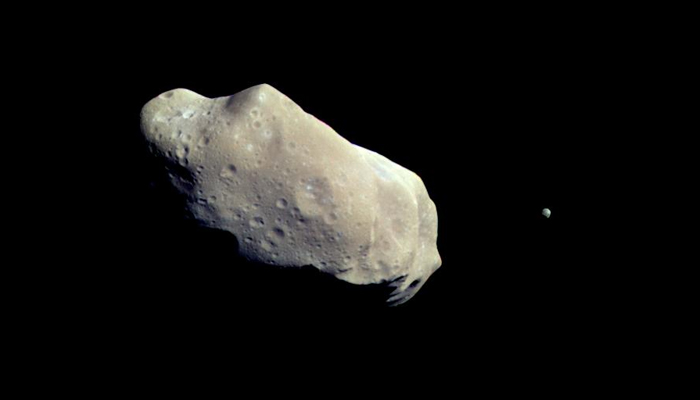NASA warns of Earth's possible collision with asteroid
Valentine Asteroid is the only object which NASA has ranked in its risk list as 1 out of 10 on Torino Impact Hazard Scale
March 10, 2023

There is a meagre possibility that an asteroid with an approximate size of an Olympic pool may strike earth on Valentine's Day in 2046, according to the National Aeronautics and Space Administration (NASA).
The chances of collision are calculated as 1 in 625 as per the data from European Space Agency. On the contrary, the possibilities revealed by NASA is 1 in 560.
The asteroid named 2023 DW — may refer to as Valentine Asteroid — with reference to a possible collision on Valentine’s day — is the only object which NASA ranked in its risk list as 1 out of 10 on the Torino Impact Hazard Scale. It is a benchmark that measures the possible risks of space objects posing a threat of striking the Earth.
According to the ranking, the collision possibility is highly unlikely, with no need to be alarmed for the earth dwellers, said the Jet Propulsion Laboratory whereas the ranking zero pertains to the zero possibility of a strike.
A navigation engineer at the Jet Propulsion Laboratory in Pasadena Davide Farnocchia believes that the object is not particularly concerning.
However, the data and analysis which is being carried out could transform the possibility of collision of Valentine Asteroid with Earth, warned the experts from the US space agency.
Taking to Twitter, NASA Asteroid Watch said: “Often when new objects are first discovered, it takes several weeks of data to reduce the uncertainties and adequately predict their orbits years into the future.”
Will it Impact?
The asteroids appear threatening when they are discovered first. As the orbits stem from very limited observation sets and are more uncertain, it is more likely that such orbits will "permit" future impacts, noted the Center for Near Earth Object Studies, located at the Jet Propulsion Laboratory, in a statement on its website.
As more and more observations and information are collected and analysed, the threat of its damage to the earth decreases. Similarly, these estimations made with the early discovery can also be declared threatening as the new information is inducted while observations clear the air regarding the object's nature and orbit.
The asteroid is measured around 160 feet in diameter, the data from NASA noted.
The asteroid 2023 DW — which orbits around the sun — is measured around 160 feet in diameter, NASA's data shows. The asteroid is expected to pass near the earth ten times with its most proximate encounter predicted on February 14, 2046, among nine others between 2047 and 2054.
NASA's Eyes on Asteroids website has underlined that the asteroid is predicted to approach earth from a distance of about 1.1 million miles. The asteroid was spotted initially on February 2 in our skies and has been travelling at a distance of more than 10 million miles with a speed of 15.5 miles per second. It will be completing its one loop every 271 days around the sun.
Farnocchia was of the view that the success of NASA's DART mission in September 2022 is evidence that humans need to be ready to encounter such asteroids on potentially disastrous courses.
Earlier, to change the course of an asteroid, DART intentionally collided with a spacecraft to change its course. It is the primary purpose of the mission which resulted in massive success for us, he highlighted.











